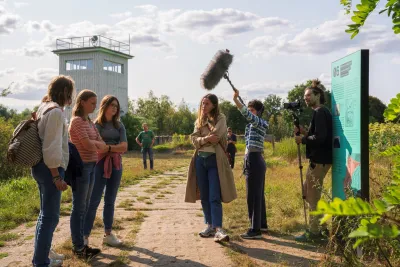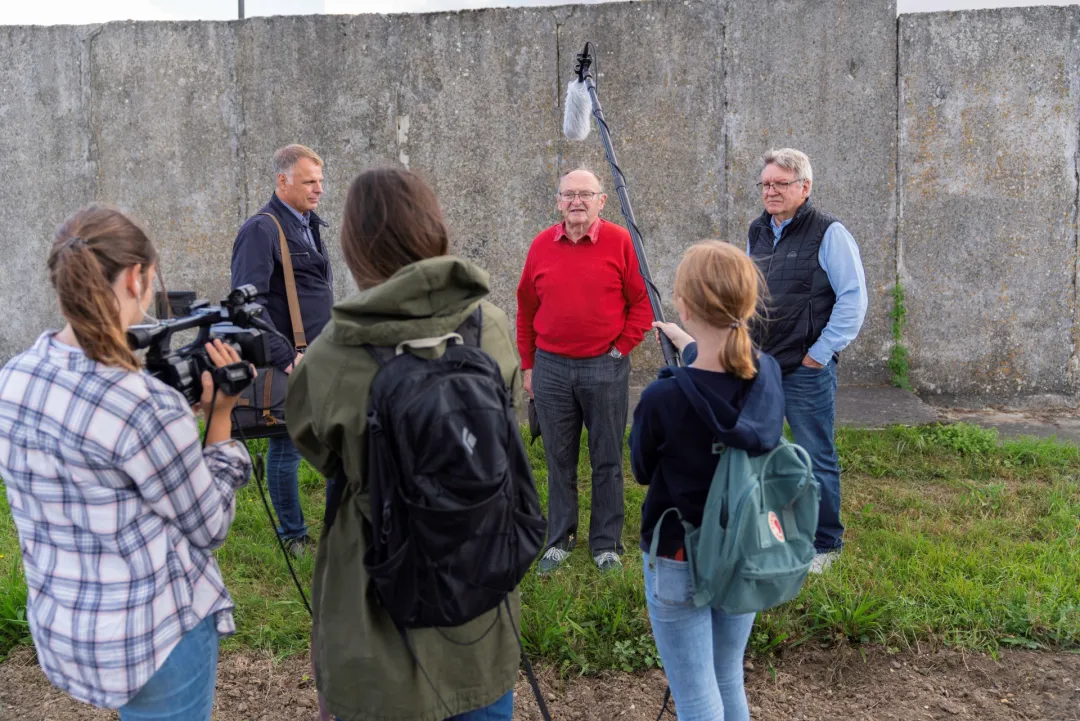General information
RDP Priority
- P6. Social inclusion and local development
RDP Focus Area
- 6B: Local development
RDP Measure
- M19: LEADER/CLLD
Beneficiary type
- Non-governmental organisation
Summary
This LEADER project got young people from two neighbouring regions on either side of the former inner-German border (known as the Green Belt) interested in the history of Germany’s division by searching for traces of the border and interviewing witnesses.
The project sought family teams: young people who, together with their parents and grandparents, would engage in a creative exchange about history and the effects of the division which can still be felt today, and make short films together to show how dialogue can work across national and generational boundaries.
Participatory approaches empowered individuals and cultivated a sense of belonging and collective identity within communities, which is vital for successful rural development. By showcasing perspectives from both sides of Germany's former divide, the project's results inspire collaboration and learning among rural populations, promoting economic resilience through shared expertise.
Results
- Thirty-five participants shot nine short films, reports, interviews and personal essays in two workshops.
- A small documentary film team followed the project to create a feature-length film, which lasted around 80 minutes and has since been shown publicly many times in both regions.
- Community engagement and participation have been facilitated by incorporating local narratives through video storytelling.

Promoter
Grenzenlos Wege zum Nachbarn e.V
Funding
Total project cost: 33 915 (EUR)
EAFRD: 20 350 (EUR)
National/Regional: 5 087 (EUR)
Private/own: 8 478 (EUR)
Ressources
Context
Germany’s reunification in 1990 marked a significant turning point in the nation’s history, yet the lingering effects of the former divide between 'east' and 'west' Germany continue to shape contemporary society. Enhancing younger generations' knowledge about this historical context can lead to benefits for rural development. By fostering a deeper understanding of their shared history, young people can cultivate a sense of identity and community, which is essential for driving local initiatives aimed at economic revitalisation.
This awareness can inspire collaborative efforts to address ongoing disparities between former East and West German regions. By engaging with this history, young individuals may be more inclined to participate in community projects that aim to bridge these gaps, such as local entrepreneurship programmes or cultural exchange initiatives that celebrate regional diversity.
Improved historical knowledge can also empower younger generations to advocate for policies that support sustainable rural development. Understanding past socioeconomic inequalities enables them to identify current issues affecting rural areas, such as population decline or outdated infrastructure, and propose informed solutions. As they actively engage with these challenges, they contribute not only to their communities’ economic resilience but also foster a sense of pride and ownership over their local heritage.
Two LEADER regions in Germany (Lower Saxony and Saxony-Anhalt) have been united by a cooperation agreement to commemorate the history of the former Green Belt border zone and to reconcile and connect the communities from across both sides.
Objectives
This German LEADER project aimed to:
- Develop innovative approaches to rural development remembrance using video storytelling skills.
- Encourage a lively coexistence, diversity and a democratic exchange between generations.
- Bring young people into an exchange with older people from the region.
- Strengthen dialogue between generations and across national borders.
- Overcome the unspoken history and 'voicelessness' more than thirty years after the opening of the border.
- Inspire those affected to tell their stories and bring them to life.
- Enable young people to reflect on elementary democratic values.
Activities
Planning and preparation:
- Preparatory meeting of project sponsors in Helmstedt.
- Information day for interested families and contemporary witnesses from the Flechtinger Höhenzug region.
- Press conference with project presentation.
- Information evening for interested families and contemporary witnesses organised by the Grünes Band im Landkreis Helmstedt region was also attended by numerous people from the Flechtinger Höhenzug region.
- Video conference with interested families and contemporary witnesses from both regions with project sponsors.
Film workshops:
- Kick-off event in the Offleben village community centre with all participants from both regions with project sponsors.
- Film workshop in Nordgermersleben/Hohe Börde.
- Film workshop in Helmstedt.
- Post-production, use, publication:
- Post-production: completion of nine short films by the participants, as well as the overall film and a short trailer.
- Preview of the complete film for the workshop participants. Public film presentations followed by discussion in Helmstedt and Hohe Börde.
- Follow up by planning further distribution of the film.
Main results
Rural development results from using video as a medium to enhance understanding of the socio-economic disparities between the former East and West Germany rural communities, including:
- Thirty-five participants produced nine short films, reports, interviews and personal essays in two workshops.
- A small documentary film team followed the project to create a feature-length film, which lasted around 80 minutes and has since been shown publicly many times in both regions.
- Increased awareness of historical contexts that shaped the two regions and social structures that emerged from the post-war division, fostering a deeper comprehension among viewers.
- Community engagement and participation have been facilitated by incorporating local narratives through video storytelling, and residents can share their experiences and perspectives on rural life in both regions.
- This participatory approach not only empowers individuals but also cultivates a sense of belonging and collective identity within communities, which is vital for successful rural development.
- By showcasing initiatives from either side of Germany's former divide, these projects can inspire collaboration and learning among rural populations, promoting economic resilience through shared expertise.
- Four days of storytelling cafés were attended by many people to create new content for the project stakeholders.
- There were also plans to create a podcast series on this topic as part of a follow-up project.
Key lessons
- Gaps between the former eastern and western Germany can be overcome. Participants were given space to talk and listen, and then were tasked with getting creative together.
- LEADER encouraged young people to engage with regional history and or socio-political values, not as students in school, but creatively and in a self-determined community-led way.
- Rural educational outcomes can be enhanced by integrating video resources into academic curricula focused on regional studies. Visual materials enhance cognitive retention by providing students with relatable content that illustrates theoretical concepts in a practical context. This transformation fosters critical thinking about historical inequalities and encourages discourse around contemporary challenges faced in rural Germany.
Our grandfather was mayor of Grasleben from 1985 to 2011 and made it his mission to 'build bridges to the (former) GDR'. He always had the vision of a united Germany, and his interest in the inhumane inner-German border continued down the generations. Even during the introductory round in the video conference for this project, it became very clear that the restrictions on freedom and democracy in the GDR have left their mark, and it can still be felt after so many years. A discussion within the framework of this intergenerational project will certainly contribute to an even greater appreciation of our fundamental constitutional rights, also among young people. Young people should become aware of the special features of the once divided Germany in our region!
I have always lived here. Together with my husband Oliver and my parents, we live in Nordgermersleben. I graduated from high school during the reunification. Today, I work as an industrial clerk and am involved in many areas on a voluntary basis. I think that is a great way to bring people together.
Herr H.-K. Otto

